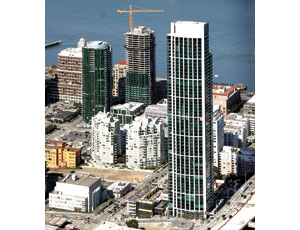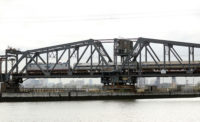Structural engineers in earthquake zones, long struggling to push the needle forward on seismic design of tall buildings, are celebrating the availability of a new design methodology. They are hailing the tool, in the form of an 84-page guide for performance-based seismic design of high-rises, as a great step forward in developing better-performing buildings that are more economical and constructible. In addition, engineers expect the guide to take some of the agita

Guidelines for Performance-Based Seismic Design of Tall Buildings Version 1.0, vetted by various structural groups and building departments in seismic zones, “is an important, industry-changing document because it will allow practicing engineers to confidently design safer, more reliable high-rises, instead of blindly following the prescriptive provisions of the building code, which may lead to undesirable results,” says Ron Klemencic, president of Seattle-based structural firm Magnusson Klemencic Associates, and a member of the nine-person working group of the Tall Buildings Initiative (TBI) of the Pacific Earthquake Engineering Research Center (PEER) at the University of California, Berkeley, which published the document.
Recommended Alternative
The guide presents “a recommended alternative to the prescriptive procedures for seismic design of buildings contained in [current standards],” says TBI, which released the document, dated November 2010, on Jan. 11. “Alternatively, individual users may adapt and modify these guidelines to serve as the basis for designs intended to achieve higher seismic performance objectives,” says TBI.
The guide also promotes best practices and consistency in approach by allowing owners and building officials to proceed confidently with the review process, adds Klemencic, an early advocate of performance-based seismic design (PBSD) of tall buildings. The engineer experienced great difficulty getting approval for the first three PBSD high-rises in San Francisco—the 38- and 43-story Infinity towers and the 64-story One Rincon Hill (ENR 1/21/08 p. 22).
Approvals for the Infinity towers took about two years, and approvals for ORH took a year. With the guidelines, approval time, which will vary from jurisdiction to jurisdiction, can be streamlined to about four months, predicts Klemencic.
The guidelines, mostly funded by $250,000 from the Charles Pankow Foundation, include concepts that may be used for PBSD in general, says Jack Moehle, a Berkeley professor of structural engineering who initiated the project in 2008.
In the last decade, structural engineers have been using PBSD with greater frequency. The problem was that procedures in use varied from job to job and from jurisdiction to jurisdiction, and engineers did not always follow the best practices, says Moehle. That created a need to get consensus around best practices, supported by research. “The ultimate goal was publication of guidelines that were widely supported in the community,” says Moehle.
Until publication of this methodology, engineers doing PBSD of tall buildings would typically start with the building code, take a few exceptions to it, such as violating the height limits for a structural system or neglecting the redundancy coefficient, says Ronald O. Hamburger, senior principal in the San Francisco office of Simpson Gumpertz & Heger and chair of TBI’s working group. Then they would design the building to the code, with the exceptions, and use a performance analysis to justify that the building would still work adequately, he says.
“The criteria throw away the code analysis,” says Hamburger, “and replace it with evaluation for a service-level quake, assuring good performance and probable continued occupancy for a likely quake, while continuing to assure survivable performance for the worst quakes.”
Procedures used in most past PBSDs used somewhat arbitrary limits on how much ductility one could use for different structural components, among them shear walls, columns, beams and slabs, he says. The guide, which eliminates arbitrary limits, allows a designer to “push” a building and its elements as far as the analytical model allows.
“This could result in some substantial additional economy,” says Hamburger.
The guidelines have also brought forward many recent advances in ground motion representation and structural modeling technology, he adds.
And the document addresses soil- foundation-structure interaction modeling. In early PBSDs, engineers did not know how to deal with deep basements in their models. “We have successfully introduced some rational procedures for this,” says Hamburger.
The biggest technical challenge in creating the methodology was getting agreement on the service-level criteria. “Ultimately, we settled on a 43-year quake, which means there is a 50% chance of occurrence in 30 years, as something that was reasonable and achievable,” says Hamburger.
The document, available online at http://peer.berkeley.edu, was informed by the Applied Technology Council’s ATC-58 project but ultimately did not incorporate it. ATC-58 is developing next-generation PBSD criteria applicable to new and existing buildings. The 75%-complete draft of the ATC-58 methodology is scheduled to be published at the end of the month and project completion is set for mid-year.
Coordination Challenge
The biggest organizational challenge in creating the PBSD guidelines was coordinating multiple tasks funded by multiple agencies with different requirements and expectations, Moehle says. The methodology was tested through TBI research, involving three case studies of buildings designed using different methodologies, including PBSD, and then compared.
Some have expressed concern that the guide’s performance objectives are essentially the same as those for ordinary buildings. But apart from concerns about a tall building with residual drifts and cladding, both covered in the guide, “we could not find a justification for requiring or recommending superior performance in general,” says Moehle.
“The PEER guidelines appear to distill PBSD information through studies and actual projects to present a very useful road map for designers interested in using PBSD,” says Dennis C.K. Poon, a managing principal of structural firm Thornton Tomasetti, New York City. “They are sprinkled with plenty of caution signs intended to minimize detours and result in a safe PBSD result.”
Most of the thornier questions in modeling, inputs and evaluation are raised, and for many, clear recommendations are provided, says Poon. “It will be interesting to see how widely the recommendations are adopted by jurisdictions around the globe, since significant differences in approach currently exist.”




Post a comment to this article
Report Abusive Comment